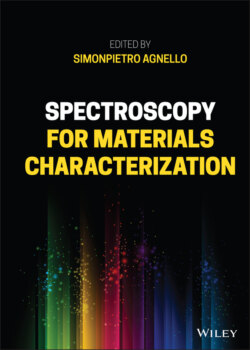Читать книгу Spectroscopy for Materials Characterization - Группа авторов - Страница 38
2.1.4 Phonon Line Structure
ОглавлениеIn the following, we deal with the phonon coupled transitions to succeed in describing the shape of the whole band and its temperature dependence; the effects of band vibrations and localized vibrations will be separately discussed.
As introduced in Section 2.1.1, band vibrations correspond to the transitions in which phonons of the matrix are created or annihilated. They appear as broad continuous bands whose shape, L vib(ω, T), depends on the spectral density of phonons and on the perturbation nearby the defect. As a consequence, L vib(ω, T) cannot be derived exactly and we will limit ourselves to indicate it by its formal expression. In fact, the integrated intensity of the whole vibronic band is given by:
(2.38)
The sum over n is an average over the vibrational levels in the ground electronic state, each level having a weight v n . The sum over m corresponds to all the possible transitions from the ground to the excited state including the ZPL (n = m). Under the Condon approximation, the previous equation can be written as:
(2.39)
where the properties of the complete set of functions φ II, m (q) have been used:
(2.40)
The last term in Eq. (2.39) becomes:
(2.41)
where N is the total number of defects in the solid matrix. Equation (2.41) indicates that I vib does not depend on the distribution function v n and, therefore, it does not change with temperature. This property leads to a constant value of the total area under the spectrum; the decrease of ZPL with increasing temperature is compensated by the increase of the other part of the spectrum (vibrational background).
Luminescence spectra have the same features provided that non‐radiative transitions are absent so as to keep constant the total area. To single out the temperature dependence of the ZPL, it is useful to consider the ratio between its intensity and that of the whole band. This relative intensity is known as Debye–Waller factor and is given by:
(2.42)
The localized vibrations cause a change of the potential curve W ls (q s ) and of its minimum position during the electronic transition. In the simplest case of a single localized mode with frequency Ω and under the approximation ℏΩ ≫ kT, the thermal excitation of the vibrational levels in the ground electronic state can be neglected. It is worth noting that, since the localized vibration frequencies are quite high (ℏΩ ∼ 10−1 eV), this condition is satisfied in a wide temperature range.
The configurational coordinate of the single localized mode is the nuclear distance R and the vibration levels are denoted as λ and λ ′ in the ground and excited electronic states. The overlap integral in Eq. (2.13) is therefore calculated between the wave function in the excited state and φ I,0(R) in the ground state where only the vibrational level λ=0 is populated:
(2.43)
For the nuclear harmonic oscillator with mass M, we can exploit the relationship , being the nuclear average displacement from equilibrium position. Then, the wave functions φ I, 0 and can be expressed as a function of the dimensionless parameter , and they assume the form of a Hermite polynomial multiplied by a Gaussian function:
(2.44)
(2.45)
Owing to the linear electron–phonon coupling approximation, the vibrational wave functions are in the following relation: φ I, 0(ξ) = φ II, 0(ξ − ξ 0), where is the shift between the two potential curves, the equilibrium position of the oscillator in electronic state II being taken as the origin. Equation (2.43) becomes:
(2.46)
where we have introduced the notation:
(2.47)
After solving this integral by parts, we obtain the transition probability W(I,0→ II,λ ′):
(2.48)
that is given by the Poisson distribution, where is the Huang–Rhys factor for the localized vibration.
Figure 2.3 displays representative patterns of Eq. (2.48) corresponding to [11]:
1 Weak electron–phonon coupling (). In this case, the maximum transition probability is that connecting the lower vibrational levels in the ground and excited electronic states, which is the ZPL.
2 Medium electron–phonon coupling (). In this case, the probability distribution is asymmetric and is peaked at vibrational levels with λ ′ > 0 and the ZPL transition is still probable.
3 Strong electron–phonon coupling (). In this case, the distribution is symmetric (Gaussian shape) and the ZPL transition probability vanishes.
